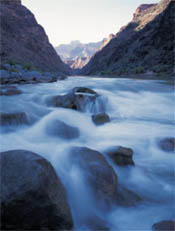 A buzzword in the environmental literature for the last decade and a half, fragmentation refers to one of the most significant problems affecting natural environments today. A process in which large, continuous areas of particular types of ecosystem (for example, forests) are carved up into small remnant patches, fragmentation results in remaining natural areas that are much less than just smaller versions of their original ecosystems.
A buzzword in the environmental literature for the last decade and a half, fragmentation refers to one of the most significant problems affecting natural environments today. A process in which large, continuous areas of particular types of ecosystem (for example, forests) are carved up into small remnant patches, fragmentation results in remaining natural areas that are much less than just smaller versions of their original ecosystems.
Habitat fragmentation, as it is referred to in environmental circles, is generally a result of human activities such as urban development or large-scale, industrial forestry operations -? activities that carve up the landscape, dividing one natural area from another. The problem with fragmentation from an ecological perspective is more than just an issue of habitat loss, or diminished space for plant and animal species to exist in. The home range of animals — the area required to sustain an individual, say a bear — is significant. Without enough geographical space in which to find food, shelter, and appropriate breeding grounds, wildlife simply cannot survive.
But fragmentation is associated with a number of additional factors that decrease the capacity of each remnant patch to support those creatures that remain. The process of breaking up continuous tracts of natural habitat into remnant patches decreases the proportion of “interior” habitat to ‘”edge habitat.” Large, intact ecosystems have vast areas of undisturbed interior habitat, and relatively little edge habitat (those areas, say, along roadways or next to agricultural land). Small habitat patches will have a great deal of edge habitat, and relatively little interior habitat. While not equally significant for all species, this ratio is key to the ability of certain species to persist.
Some species of both plants and animals depend on conditions typical of the interior of ecosystems. A forest illustrates well the significance of interior versus edge conditions: interior habitats are associated with relatively low light levels and high moisture conditions, while edge areas (such as the border between a forest and a farmer’s field) are subjected to higher intensity light, as well as greater air movement, both of which lead to more rapid drying of the soil. Species adapted to interior conditions cannot tolerate the desiccating conditions typical of edge habitats, and therefore will fare poorly in fragmented landscapes.
An additional problem facing small remnant patches is their increased vulnerability to invasive species -? aggressive plants and animals (often native to far-flung locales such as Asia or Europe) that are able to out-compete native species. Invasive plant species are often those that are specifically adapted to conditions typical of edges. Growing rapidly in the high-light environments of edges, and capable of tolerating the harsh drying conditions of these areas, invasive species can often gain a toehold in small habitat fragments. With a greater proportion of edge habitat to interior habitat, these species are given a good head start on working their way into and throughout a remnant patch.
Another issue associated with fragmentation is that of remnant patch isolation. The separation of one habitat patch from another presents very real difficulties for wildlife in terms of finding appropriate mates (especially for small or “shy” land animals, which may not be able to move between habitat patches separated by roadways, developed urban areas or open agricultural areas). Even if mates can be found within a habitat remnant, genetic isolation can begin to be a problem in isolated patches, with the effects of inbreeding taking a toll on species’ health. Plants are also affected by patch isolation; seed dispersal (often facilitated by wildlife) may not occur in fragmented landscapes, placing species in danger of genetic isolation.
Habitat fragmentation may be taking a back seat these days with all of the focus on global climate change, but the significance of fragmentation hasn’t waned, and may only be increasing: stresses placed on ecosystems and their component species may well be compounded by the effects of habitat loss, patch isolation and climate change.
It makes you look twice at those little patches of natural environment, scattered throughout our landscapes.

